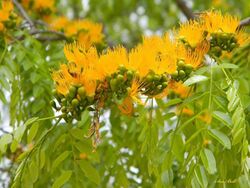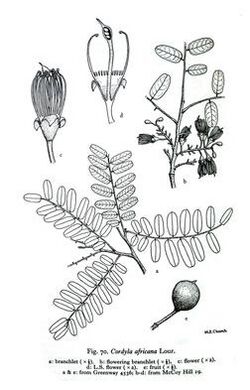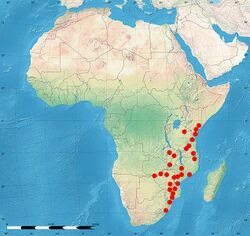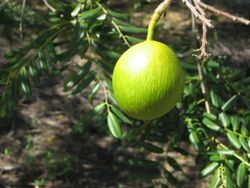Biology:Cordyla africana
| Cordyla africana | |
|---|---|

| |

| |
| Plate by Maureen E. Church | |
| Scientific classification | |
| Kingdom: | Plantae |
| Clade: | Tracheophytes |
| Clade: | Angiosperms |
| Clade: | Eudicots |
| Clade: | Rosids |
| Order: | Fabales |
| Family: | Fabaceae |
| Subfamily: | Faboideae |
| Genus: | Cordyla |
| Species: | C. africana
|
| Binomial name | |
| Cordyla africana Lour.
| |

| |
Cordyla africana is a tall (up to 25 m), deciduous African tree with a large, spreading, much-branched crown, and a bole of some 2.2 m dbh. It is a member of the large leguminous family Fabaceae, and is known as wild mango in some areas. It is found up to 1000m elevation in large river valleys, in miombo woodland and coastal swampy evergreen forest, mostly on sandy soils, along the eastern parts of central and southern Africa. It occurs in South Africa in KwaZulu-Natal and Mpumalanga provinces, the Kruger National Park, Eswatini, Mozambique, Zimbabwe, Zambia, Malawi, Kenya and Tanzania.[1] 'Cordyla' is from the Greek word 'kordyle', meaning a 'club' and is a reference to the club-shaped fruit and stalk.[2]
The mature bark is rough, dark brown and fissured, and a blaze showing yellow with orange streaks. The flowers are without petals and display yellow to orange stamens in axillary racemes 50mm long with up to 12 flowers, and these appear with the new leaves in September. As with Schotia flowers they face up and are nectar-filled, attracting a wide variety of birds.
Unusually for the legume family, the fruit develops from the standard pod shape when young, into an indehiscent, up to 80 mm long golden-yellow and glossy ovoid fruit with a thick stalk. When mature it has a soft, thin skin with a slight depression on one side. Fruit falls when not quite ripe, and fully ripens on the ground. One to eight large brown seeds are enclosed in a yellow, sticky pulp, and these frequently germinate from within the fruit. The fruit is rich in Vitamin C and is sought after by many mammals, including elephant. (see Mfuwe Lodge) The leaflets show transparent gland dots and streaks when backlit. The twigs and green fruit exude latex when damaged.
The tree was first described from Portuguese East Africa by the Jesuit priest João de Loureiro (1710-1791), who spent time as a missionary in Goa, Macao and Cochin China, but was also a naturalist and mathematician. There are 8 species of Cordyla currently recognised, confined to the eastern parts of Africa and the island of Madagascar .
References
External links
Wikidata ☰ Q5170089 entry
 |


